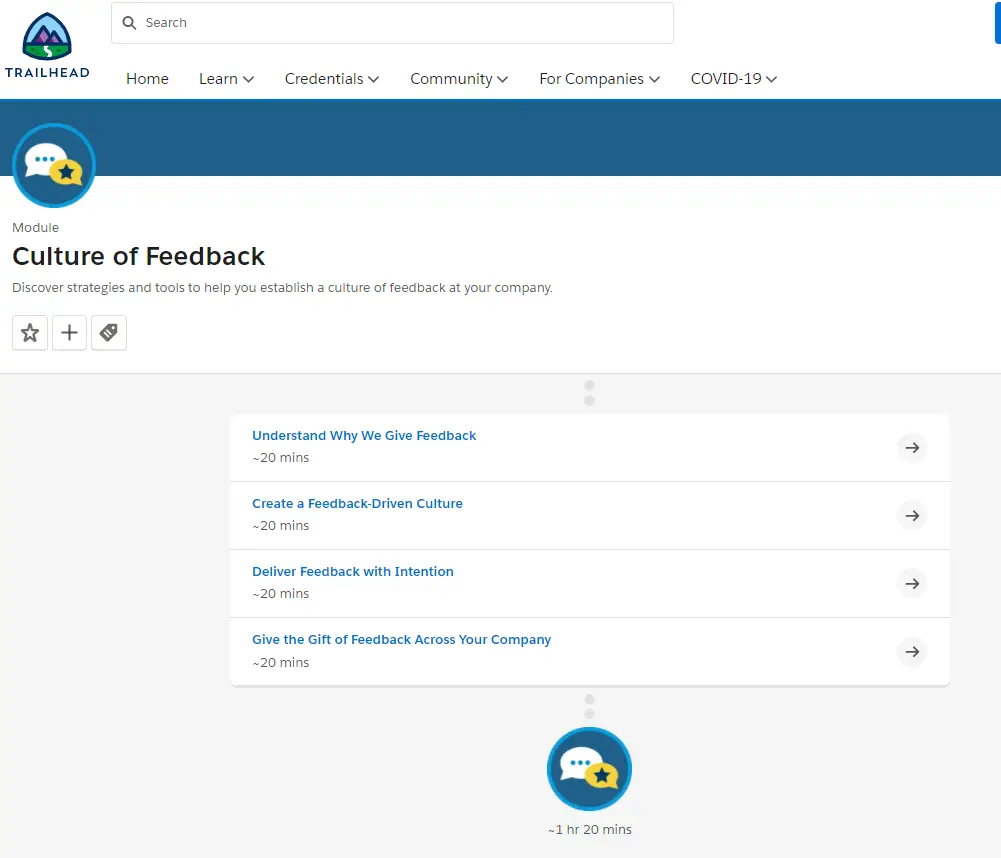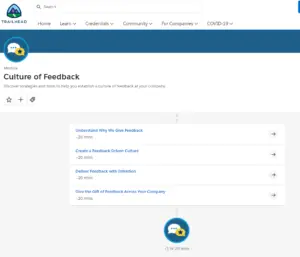In this article we will see the answers of General Courses: Culture Of Feedback & will see the important, types, example, benefit and use culture of feedback.
A culture of feedback is one of the best ways to make sure that you are building a better brand. You can’t build anything without criticism, and if you want to build something great, you need feedback from people who aren’t afraid to tell you what’s wrong with it. The only way for your brand to become great is for it to go through a lot of work, which means that there will be plenty of chances for your brand to improve as it becomes more popular.

#1.Understand Why We Give Feedback
Q1)Managers who are rated best at giving ongoing feedback:
I)Are most likely to be promoted
II)Build teams of actively engaged employees
III)Are often rated as not caring personally about their employees
IV)Are often lacking feedback themselves
[bg_collapse view=”button-orange” color=”#4a4949″ expand_text=”Show Answers” collapse_text=”Close Answer” ]
II)Build teams of actively engaged employees
[/bg_collapse]
Q2)In a feedback culture:
I)Trust and transparency are present
II)Giving and receiving feedback is the norm
III)Feedback is focused on progress and continuous improvement
IV)All of the above
[bg_collapse view=”button-orange” color=”#4a4949″ expand_text=”Show Answers” collapse_text=”Close Answer” ]
IV)All of the above
[/bg_collapse]
Q3)At Salesforce, creating a feedback culture starts with grounding the approach in:
I)Our clouds
II)The Salesforce Ohana values
III)The Salesforce advantage
IV)The Salesforce corporate V2MOM
[bg_collapse view=”button-orange” color=”#4a4949″ expand_text=”Show Answers” collapse_text=”Close Answer” ]
II)The Salesforce Ohana values
[/bg_collapse]
#2.Create a Feedback-Driven Culture
Q1)What is the best strategy for giving feedback that’s timely and ongoing?
I)Write down your observations, make feedback part of check-ins, and deliver within 48 hours
II)Deliver via email, leave a note on the desk, and send a text message
III)Schedule a feedback meeting while the person is on vacation, when it’s convenient for you, or via a video conference
IV)Spend a few days planning your feedback, talk to your coworkers about which approach is best, and consult the person’s manager
[bg_collapse view=”button-orange” color=”#4a4949″ expand_text=”Show Answers” collapse_text=”Close Answer” ]
I)Write down your observations, make feedback part of check-ins, and deliver within 48 hours
[/bg_collapse]
Q2)Courageous feedback is:
I)Feedback you give even when it’s tough
II)Part of being open, honest, and true to our value of transparency
III)Direct, but also respectful
IV)All of the above
[bg_collapse view=”button-orange” color=”#4a4949″ expand_text=”Show Answers” collapse_text=”Close Answer” ]
IV)All of the above
[/bg_collapse]
Q3)Specific and behavior-focused feedback is even more effective when you:
I)Write down all the details first in an email and then send it before the meeting
II)Use SBI to explain the impact of a person’s behavior
III)Like the person you’re giving feedback to
IV)Know how to surf
[bg_collapse view=”button-orange” color=”#4a4949″ expand_text=”Show Answers” collapse_text=”Close Answer” ]
II)Use SBI to explain the impact of a person’s behavior
[/bg_collapse]
#3.Deliver Feedback with Intention
Q1)A “__ mindset” is centered on the belief that people can get better through dedication, hard work, and effort.
I)Progressive
II)Fixed
III)Growth
IV)Stable
[bg_collapse view=”button-orange” color=”#4a4949″ expand_text=”Show Answers” collapse_text=”Close Answer” ]
III)Growth
[/bg_collapse]
Q2)When planning to give feedback with good intent, think about:
I)Your intentions, the context, and how to build trust
II)Your intentions, making it quick, and sending an email in advance
III)Your intentions, doing what’s best for the business, and avoiding conflict
IV)Singing “I’m just a soul whose intentions are good”
[bg_collapse view=”button-orange” color=”#4a4949″ expand_text=”Show Answers” collapse_text=”Close Answer” ]
I)Your intentions, the context, and how to build trust
[/bg_collapse]
Q3)To display intellectual curiosity when receiving feedback, what are some things you could say?
I)It’s interesting that you should say that, can you tell me more?
II)Can you share an example of a time you noticed this?
III)In that situation, what do you think I could have done differently?
IV)All of the above
[bg_collapse view=”button-orange” color=”#4a4949″ expand_text=”Show Answers” collapse_text=”Close Answer” ]
IV)All of the above
[/bg_collapse]
#4.Give the Gift of Feedback Across Your Company
Q1)Lateral feedback is feedback that’s given from:
I)Manager to employee
II)Employee to manager
III)Manager to client
IV)Peer to peer
[bg_collapse view=”button-orange” color=”#4a4949″ expand_text=”Show Answers” collapse_text=”Close Answer” ]
IV)Peer to peer
[/bg_collapse]
Q2)To give feedback that keeps biases in check:
I)Use broad generalizations rather than focusing on specifics
II)Withhold feedback
III)Focus on specific behaviors rather than generalizations
IV)Vent to your pal by the watercooler
[bg_collapse view=”button-orange” color=”#4a4949″ expand_text=”Show Answers” collapse_text=”Close Answer” ]
III)Focus on specific behaviors rather than generalizations
[/bg_collapse]
Q3)As a manager, you can “walk the talk” and model the values of a feedback culture by:
I)Proactively asking for and giving feedback
II)Acknowledging and discussing your own mistakes, shortcomings, and development opportunities
III)Practicing the elements of the feedback culture discussed in this unit
IV)All of the above
[bg_collapse view=”button-orange” color=”#4a4949″ expand_text=”Show Answers” collapse_text=”Close Answer” ]
IV)All of the above
[/bg_collapse]
What is a feedback culture?
Let’s be honest here – the average person who visits your website is not very likely to leave a comment or fill out a survey. However, if you want to build a strong and responsive customer base, collecting feedback is crucial. What if I told you that there is a way to make it easier for people to provide you with feedback? What if I told you that there is a way to make it fun for them?

How to create culture of feedback?
In order to improve your product, you need feedback. If you’re like most companies, you try to get this feedback by posting your ideas to get comments, or sending out an internal survey. While that is great, there’s a quicker and more effective way to get feedback: solicit it directly from your customers. By using the right tools and strategies, you can start to solicit feedback automatically and on a regular basis. This is how you create a culture of feedback within your organization.
Why culture of feedback is important?
Creating feedback loops is important to the success of any business. It allows you to learn from your mistakes and to improve upon your successes. Without a feedback loop, businesses quickly become stagnant and unproductive.
Feedback loops can be used in every aspect of your company, from customer service to product development. They help you identify what is working and what isn’t so that you can make changes on the fly as you move forward.
There are many different ways to implement feedback loops into your business, including surveys, A/B testing, focus groups, and exit interviews. But not all methods have.
feedback culture examples
“The evolution from static to dynamic, from the single-loop learning of bureaucracy to the double-loop learning of organizations is not a revolution but an evolution.
Sending feedback is a great way to improve performance and encourage career development, but it’s often misused. The trick is to use it to develop employees, not just identify their mistakes.
“What is feedback? Feedback is information about the consequences of our actions and the results we achieve. It’s an essential ingredient for learning and development.”
why feedback is important for students?
Students should be aware that their professors are concerned about how well they’re doing in their classes. They’re not concerned about whether they’re doing well in their classes.
“We have to get students out of the mindset that you can just do what you want and it doesn’t matter,” he said. “They need to understand that.
They’re not concerned about whether they’re doing well in their classes. “We have to get students out of the mindset that you can just do what you want and it doesn’t matter,” he said. “They need to understand that.
They’re not concerned about whether they’re doing well in their classes. “We have to get students out of the mindset that you can just do what you want and it doesn’t matter,” he said. “They need to understand that.
why feedback is important in the workplace?
It is hard to believe that we can learn something new every day. But it is possible. If you look around you, you will see a huge number of things that you have never seen before. You can learn something new every day by paying attention to the people around you. For example, you can observe the way a teacher teaches a class and then apply those techniques in your own class. You can also notice how other people handle their work and learn something from them. The workplace is one of the best places to learn because people there are focused on learning and growing as individuals, and as a team.
Whats does feedback mean?
The term Feedback is widely used in the business world. It is something that every company needs to stay on top of. However, many businesses struggle to get feedback from their customers. This is because they don’t ask for feedback in a way that gets people to respond. So how do you get your clients and customers to give you feedback? Here are some tips to increase the chances of getting feedback:
1. Get personal: Personalize emails by using their first name to build trust and make your emails more effective. If they know you have taken the time to learn their name, they’re more likely to read your email.
2. Be specific: When you’re asking for a favor, be as specific as possible about what you need and why it is important to you. Don’t make the person reading your email guess what you want.
3. Keep it short and sweet: The longer your email, the less likely the person will read it in its entirety. Keep your emails to a maximum of three paragraphs. If you have more information to share, send a follow-up email.
4. Be polite and respectful: Avoid using “You” statements (“You need to…”) or accusatory language (“Why didn’t you…
What is good feedback?
A manager or project leader is a facilitator of ideas. As such, they need to be able to interpret and digest feedback from those they manage while also filtering out the noise and unhelpful information. In my experience, good feedback is a combination of three factors:
The facts – what happened, what was said, what was done.
The feelings – how the feedback-giver felt about the situation.
The needs – what the feedback-giver wants to see happen as a result of this situation.
How do you give feedback?
Giving feedback is a little easier to answer than receiving it. When you receive feedback you have to absorb it, process it, and decide how to respond. It can be difficult to accept feedback when you know that the person giving it isn’t perfect either. The key is to focus on the solution, not the problem. The person giving your feedback has no way of knowing what solutions you might have already tried. They may have a good idea about what doesn’t work for them, but they don’t know what does work for you. When you ask for feedback, explain that you are looking for solutions.
Giving feedback is a little easier to answer than receiving it. When you receive feedback you have to absorb it, process it, and decide how to respond. It can be difficult to accept feedback when you know that the person giving it is biased.
The feedback I received from my mentor was that I was a good writer, but needed to be more careful about my spelling and grammar. This was very useful feedback for me because I knew that my mentor was not a native English speaker, so I knew that she was not being too harsh on me. I had to work hard to ensure that my writing was as good as it could be.
What are the 4 types of feedback?
When you are developing or designing a product or service, you need to know what other people think of your product. There are different types of feedback that you can get:
Product feedback – This is feedback on the features, design, and usability of a product or service. This is the most important type of feedback that you should be asking for.
HR feedback – This is feedback from the employees about their working environment and the leaders.
Training feedback – This is feedback about training programs used by the company.
Service feedback – This is feedback from customers about the services of a company.
What is an open feedback culture?
An open feedback culture can be a powerful tool for organizations. When employees feel comfortable and safe expressing their concerns, the entire organization benefits. With open feedback comes a culture of continuous improvement and a more engaged workforce, which leads to better company results. # How to adopt an open feedback culture?
5 Benefits of a culture of feedback
Feedback is a critical component of business. In fact, it can make or break an organization. Feedback is important whether we’re talking about positive feedback (like praise) or negative feedback (like criticism or conflict). The problem with many businesses is that they’re too vague and unspecific when giving feedback. For example, a boss might tell an employee, “You need to be more upbeat at work.” What does that mean? How should the employee improve? More importantly… how will the boss know if the employee has improved?
In order to give effective feedback, you need to be specific. And in order to get the most out of your feedback, you need to be open and receptive. Here are some tips for giving and receiving feedback:
5 Benefits of a culture of feedback:
1) Saves time, money, and resources.
2) Creates an environment of accountability.
3) Promotes learning and growth.
4) Increases productivity.
5) Improves quality of work life.
List Of Trailhead Salesforce Modules:
- Module: Big Object Basics -Salesforce Answers
- Module: Event Monitoring -Salesforce Answers
- Module: Platform Cache Basics -Salesforce Answers
- Module: Org Development Model -Salesforce Answers
- Module: Change Set Development Model -Salesforce Answers
- Module: Application Lifecycle And Development Models -Salesforce Answers
- Module: Platform Events Basics -Salesforce Answers
- Module: Asynchronous Apex In Salesforce (Answers)
- Module: User Interface API Salesforce Answers
- Module: Quick Start: Lightning Web Components (Answers)
